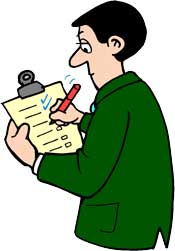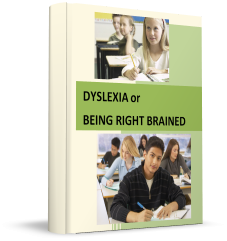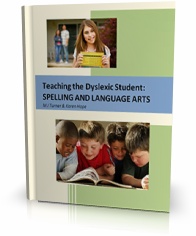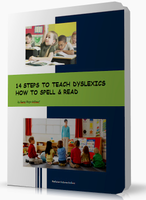 You have just been told your child or student may be dyslexic. You are an adult who has been having reading and spelling problems your whole life and have been wondering if you are dyslexic. How can you know for sure? How can you help? Where do you start? The word dyslexia is derived from the Greek word, dys (meaning poor or inadequate) and the word lexis (meaning words or language)and it is used as a general term to cover many different learning problems. If you or your student has been diagnosed as "dyslexic", it does not have to mean that you have a learning disability but rather a right-brained learning style that can be managed and used very effectively. Start with the following Dyslexia Check List to discover which of the learning problems you, your child or your student have. You and your student should work together to check off the learning problems. Any section that you mark with 50% or more points indicates dyslexic learning weaknesses in that area. Also we have some guides for assessing at the end of the checklist.
You have just been told your child or student may be dyslexic. You are an adult who has been having reading and spelling problems your whole life and have been wondering if you are dyslexic. How can you know for sure? How can you help? Where do you start? The word dyslexia is derived from the Greek word, dys (meaning poor or inadequate) and the word lexis (meaning words or language)and it is used as a general term to cover many different learning problems. If you or your student has been diagnosed as "dyslexic", it does not have to mean that you have a learning disability but rather a right-brained learning style that can be managed and used very effectively. Start with the following Dyslexia Check List to discover which of the learning problems you, your child or your student have. You and your student should work together to check off the learning problems. Any section that you mark with 50% or more points indicates dyslexic learning weaknesses in that area. Also we have some guides for assessing at the end of the checklist.
If you have any questions about the checklist or need further support please email us at sales@dyslexiavictoria.ca
Spelling
_____1. Cannot name the letters of the alphabet in sequence
_____2. Cannot count in sequence to twenty or higher
_____3. Mixes up letter order in words: "pasghetti" with "spaghetti"; "ciminon" with "cinnamon"
_____4. Misspells words
_____5. Reverses letters "b" for "d" or "p" for"q", even whole words
_____6. Reverses the last letter of a word with the first letter
_____7. Cannot spell simple words correctly
_____8. Fails to recognize the same word twice or later on the same page
_____9. Spells a word several different ways
_____10. Cannot do a spelling test correctly if the words in the original list are dictated in a mixed order
Reading
_____1. Confuses verb tenses may mix up: see, saw, seeing.
_____2. Reads slowly and below grade level
_____3. Continues having many reading problems as they move through the grades.
_____4. Does not seem to understand what he or she has read.
_____5. Has difficulty hearing and repeating words of another language
_____6. Has problems understanding and spelling abstract words, especially those about time and place
_____7. Mispronounces or misreads many words
_____8. Decodes words too slowly while reading and loses comprehension
_____9. Has an inadequate reading vocabulary
_____10. Fears having to read aloud in class
_____11. Has difficulty remembering content just read in a story
_____12. Has difficulty remembering information just read in a list
_____13. Requires more time to read or answer questions than other students
_____14. Has difficulty tracking a printed line across the page
Mathematical Concepts
_____1. Does not understand the concept of time
_____2. May not be able to tell time correctly up to ten to twelve years of age
_____3. Cannot do simple mathematical word problems without referring to pictures, concrete objects or counting on their fingers
_____4. Does not understand simple fractions such as half a cup of sugar or three quarters of an orange
_____5. Cannot understand money unless taught by holding the coins and bills in their hands and actually buying something
_____6. Does not understand flat, two dimensional drawings as opposed to three dimensional views of actual objects
_____7. Cannot understand measurements: linear, weights, quantity or volume
_____8. Does not understand or has difficulty with long division
_____9. Is not able to memorize the multiplication tables
_____10. Does not understand fractions, percentages or decimals.
General Problems
_____1. Has difficulty following spoken or written instructions
_____2. Does not know what is expected of them when given oral instructions that are not complete
_____5. Cannot copy notes from the board accurately
_____6. Has difficulty copying geometric designs
_____7. Cannot explain "cause and effect" in a picture of a scene or a story, or predict what may happen next
_____8. Can remember more information when hearing it read aloud or discussed than when they read it silently to themselves
_____9. Can do a learning task better if they can see it and handle the parts first
_____10. Can answer questions orally, but poorly in writing
_____11. Freezes up when asked to give hand-written answers in sentences, paragraphs or essays
_____12. Has difficulty with spelling, punctuation, grammar and writing.
_____13. Cannot focus on a few ideas at a time, so cannot stay on task.
_____14. Has difficulty memorizing poems
General Problems
_____1. Is a poor speller.
_____2. Is unable to use the abstract concepts of time, money, measurements, fractions, percentages and other mathematical concepts.
_____3. Has problems following verbal and written directions.
_____4. Has difficulty making notes, copying notes or taking them down from the black board
_____5. Lacks logical sequence of thoughts when discussing or writing essays
_____6. Does not stay on task well and gives up easily.
_____7. Has difficulty picking out the main points in a paragraph or essay.
_____8. Tends to go off on tangents when discussing or writing about a topic.
_____9. Cannot focus or present thoughts in a logical order such as when trying to write a paragraph.
_____10. Must be given full, exact instructions that explain the entire concept of an assignment.
_____11. Tends to have hand printing that is disjointed.
_____12. Mixes capitals with lower case letters.
_____13. Uses both printing and cursive script in the same word or sentence.
_____14. Thinks and communicates best when moving about or handling objects.
Spelling
_____1. Confuses shapes of letters with other letters.
_____2. Experiences letter and word reversals both writing them or reading them ("dall" instead of ball, "qack" instead "pack").
_____3. Changes the spelling of words with each use.
_____4. Spells phonetically as they hear the words pronounced.
_____5. Omits or adds consonants and vowels to words.
_____6. Spells orally but not be able to pick out the written word in context or a spelling list.
Reading
_____1. Reads slowly, lacks comprehension of what was read.
_____2. Lacks a sufficient vocabulary of memorized written words.
_____3. May be unable to read because words actually appear to be "falling off the page" or they see the letters as a jumble of black markings on white paper.
_____4. Understands what is read to them orally more easily than what they read for themselves
_____5. Has difficulty with spelling so guesses at the meaning of words in context, causing a misunderstanding of the content
_____6 . Memorizes the overall appearance and sound of the words, but cannot see the individual letters within the words, which causes them to mix up letters or losing the meanings of the words
We recommend our books for students and adults having problems with:
SPELLING - "Teaching the Dyslexia Student: Spelling and Language Arts"

 My mother, Janice Turner, was a high school English teacher for thirty years, beloved by her students because of her innovative teaching techniques and passion for doing whatever she could to help her students succeed in their education.
My mother, Janice Turner, was a high school English teacher for thirty years, beloved by her students because of her innovative teaching techniques and passion for doing whatever she could to help her students succeed in their education.
At a time when teaching methods were not very flexible, she experimented with different approaches to get her students involved and excited about English language and literature. For years after she retired her students came to visit and thank her for her dedication and support even after they went on to college.
After she retired, the two of us worked together studying dyslexia and helping our family members and many other students, parents, teachers and adults struggling with dyslexia. We worked with many dyslexic students, applying the same innovative approach, trying various methods until we found what worked best for each one.
We realized they have learning issues in common but are also individuals and each student needs to be taught according to their strengths and not their weaknesses.
Our books are dedicated to all the dyslexics we've worked with and to teachers and parents everywhere who are working with dyslexic students struggling to learn with teaching methods that don't work for them.
"Teaching the Dyslexic Student: Spelling and Language Arts" is a simple introduction to helping dyslexic students improve their spelling and language arts skills and includes many easy to use practice techniques.
"Dyslexia or Being Right Brained" explains how dyslexics process information and what they need to be successful in the classroom. It will explain why right-brained students process information differently than their left-brained peers. We have also included for parents and teachers a variety of simple-to-read instructions and exercises on how to teach dyslexics. ~Karen Hope
Teaching Guide for Beginning Readers: "14 Steps to Teach Dyslexics How to Spell & Read"
Over the last thirty years I have been researching Dyslexia to understand what it is and how to teach and accommodate those with Dyslexia. My reason for this passion was due to having three Dyslexic children and no help from the schools.
"14 Steps to Teach Dyslexics how to Spell and Read" is a group of teaching and studying techniques I compiled over the years that work really well for the Dyslexic student. Many schools for Dyslexics around the world use these methods in their own school programs. These practice methods utilize a Dyslexic's need to see the "big picture" of any subject matter and focus on concrete whole ideas.
Spelling becomes more about words being whole word images representing real things or concepts. This helps the Dyslexic student connect with words their way so they can retain them, spell them and use them correctly. This book fully explains the techniques with examples that any teacher, tutor or parent can use without any specialized training.
~Karen Hope
